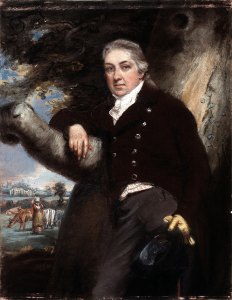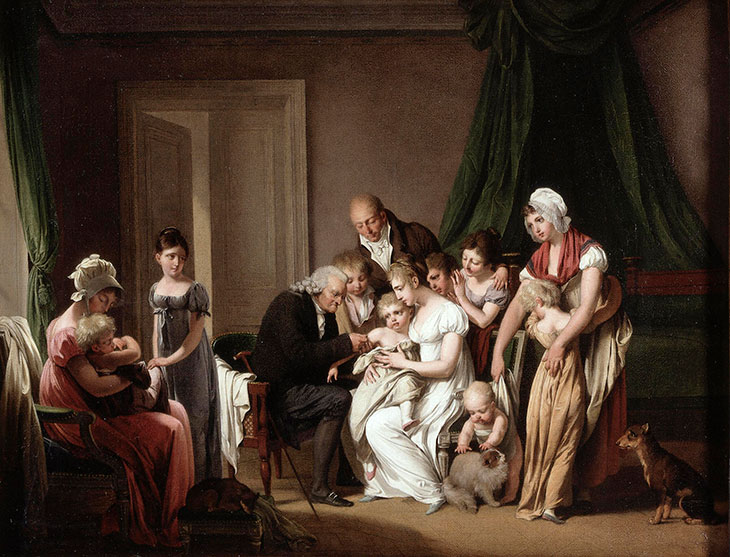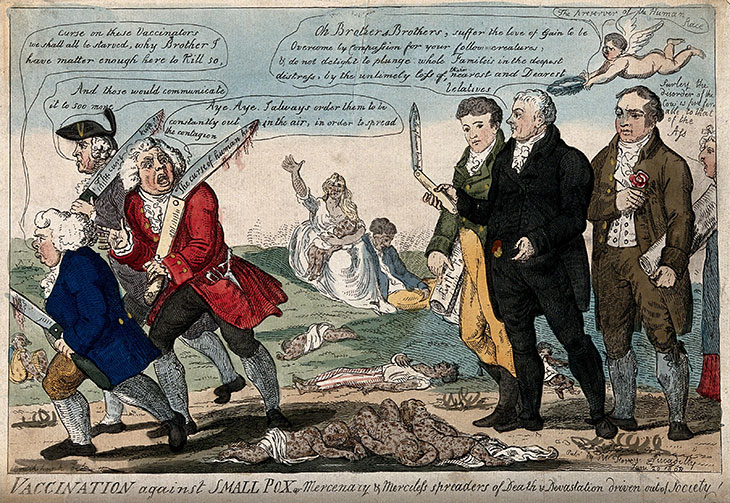One artist who knows all too well what having Covid-19 can feel like is Luke Jerram. He recovered from the virus two months ago but is still feeling the effects. ‘My sense of smell is shot, I have tinnitus and still feel tired at times,’ he says. Since 2004, Jerram has worked on a series of glass-blown sculptures of disease-causing viruses; during his convalescence, he decided that his next artwork would focus on the Covid-19 vaccines, as a tribute to the scientists and medical teams who have been coordinating their efforts across the world to fight the disease. He has now unveiled his glass sculpture of the Oxford/AstraZeneca vaccine, which at 34 centimetres wide is one million times larger than the nanoparticles in the vaccine. ‘It’s brilliant that such effective vaccines have been created in such a short space of time and that here in the UK we’ve been able to roll them out so quickly,’ he says.
As long as there have been vaccines, there have been anti-vaxxers – albeit making their case in very different scientific and medical contexts from those of 2021. Today there is a wealth of research that roundly debunks the various myths and anxieties around vaccination, many of which are strikingly similar to those circulating in the 19th century. Then as now, artists and illustrators have produced an invaluable record of a range of attitudes to vaccination.
Edward Jenner (1800), John Raphael Smith. Wellcome Collection, London (CC BY 4.0)

When, back in 1796, Edward Jenner inoculated his gardener’s eight-year-old son with the pus from cowpox blisters – thereby conferring a level of immunity against smallpox – the physician was widely lauded for his discovery. Portraits of Jenner – such as that by John Raphael Smith, made in 1800 – cast him in a heroic light, resting his arm against a tree in a pastoral arcadia, a cow herd attended by a milkmaid glimpsed in the background. (Not to be outdone, supporters of the ostracised Dorset farmer Benjamin Jesty, who had treated smallpox using cowpox some 20 years before Jenner, insisted Jesty sit for a suitably adulatory portrait by Michael William Sharp, depicting a ‘countenance which at once be-tokened firmness and superior intelligence’.)
Louis-Léopold Boilly’s L’innoculation (c. 1807), meanwhile, depicts more hesitant early attitudes to vaccination. A family clusters around a child on its mother’s lap, its limp arm hanging down to receive its injection. While some of the observers appear simply curious about the event, the trepidation felt by other family members – eyebrows raised and mouths downturned – is plain to see.
L’innoculation (c. 1807), Louis-Léopold Boilly. Wellcome Collection, London (CC BY-NC 4.0)

Covid-19 vaccines have inspired numerous conspiracy theories, ranging from the belief that they alter DNA to the suggestion that their injection implants trackable microchips in the human body. In the 19th century, some fantasists believed that the smallpox vaccine might result in nothing less than becoming bovine. In The Cow-Pock (1802), James Gillray satirised the public’s fears with a procession of grotesque patients being spoon-fed the ‘vaccine pock hot from ye cow’ before beasts burst out of their every orifice.
The Cow-Pock (1802), James Gillray. Library of Congress, Washington, D.C.

There were other motives for anti-vaccination sentiment. The introduction of vaccines had an economic impact upon practitioners of an earlier, more precarious method known as ‘variolation’, which involved infecting children with a small dose of smallpox to build immunity. In an etching of 1808 by Isaac Cruikshank, Jenner and his colleagues are shown driving three irate variolators away, who curse the vaccinators for ‘starv[ing]’ them of patients, while leaving in their shadows the smallpox-ridden corpses that lie on the ground. Variolation was eventually banned with the first vaccination act, passed in 1840, which also provided free vaccinations for the poor.
Vaccination against Smallpox (1802), Isaac Cruikshank. Wellcome Collection, London (CC BY 4.0)

Satirical artists also took aim at those who had been poorly informed regarding the process of vaccination – highlighting the importance of accurate and widely accessible education and information in any successful public health campaign. In the late 19th century, the cartoonist George Du Maurier lampooned the working classes for finding vaccination too difficult a word to say or spell, and in a Punch illustration of 1873, he depicted a doctor informing the well-to-do Mrs Fitzbrowne that he is vaccinating her baby using fluid from the pustule of a ‘very healthy child’ of her neighbour, Mr Jones. ‘Oh dear, Doctor!’ she responds. ‘I could not permit that. We do not care to be mixed up with the Joneses in any way.’ (This process, of arm-to-arm vaccination, was in fact quite dangerous and was banned in 1898.)
Today, smallpox has been eradicated – but vaccines continue to play a role in the prevention of countless other diseases. In 2015 the Gates Foundation sponsored the Art of Saving a Life campaign, commissioning more than 30 artists to highlight the importance of vaccines. Artists who took part, such as the British sculptor Katharine Dowson, are now planning how they can help the public understand what scientists are up to with the current Covid-19 vaccination programmes. ‘Scientific language can be very alienating,’ she says, ‘and a visual representation can help people become aware. There’s something tangible rather than a whole lot of gobbledegook on a piece of paper.’



